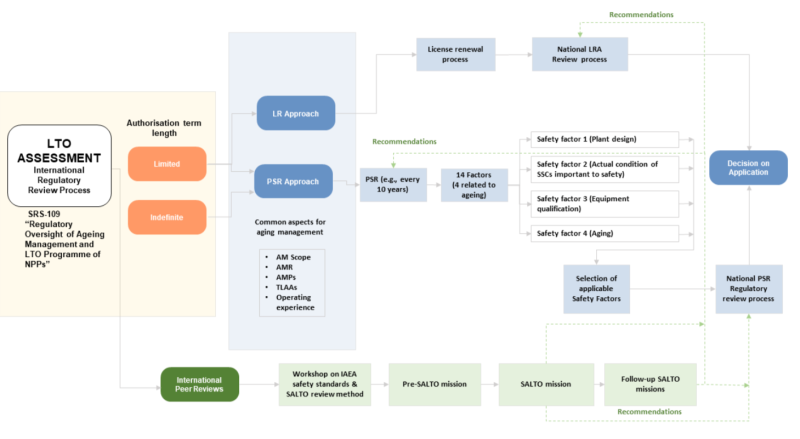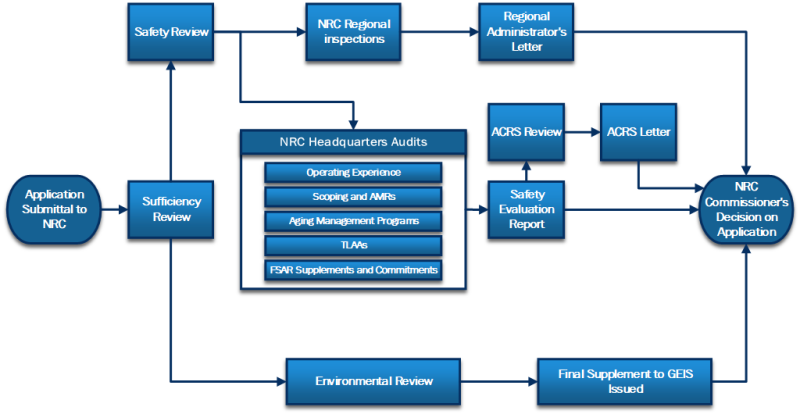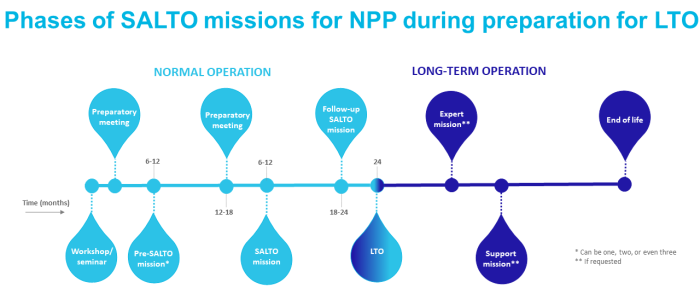Review of License Renewal Applications (US NRC and International
The major steps in the United States Nuclear Regulatory Commission (US NRC) safety review are:
- Sufficiency Review and Docketing
- Safety Review Process
- Advisory Committee on Reactor Safeguards (ACRS)
- Environmental Review
- US NRC Commissioners Review
US NRC Review Timeline[edit]
- Sufficiency Review – 2 months
- US NRC Staff and Regional review – 14 months
- ACRS review – 1 month
- Commissioners’ decision – 1 month
- Total duration from submittal to issue of new license - 18 months. This may vary depending on technical issues with the application and filing of contentions by the public. Contentions may add 3 to 6 months, or more, to the timeline.
The following diagram is a visual of how the different parts of the US NRC review discussed in this subpage, fit together.
Sufficiency Review and Docketing[edit]
The Sufficiency Review is a high-level review of the license renewal application (LRA) to confirm that the application includes the correct types of information at a level of detail that the US NRC can review to make a determination to issue a renewed operating license.
The Sufficiency Review is NOT a technical review of the correctness or adequacy of the application.
The US NRC process for determining sufficiency is documented in Section 1.1 of both NUREG-1800 and NUREG-2192; the US NRC Standard Review Plans for initial and subsequent license renewal (LR). This includes an US NRC acceptance review checklist (see Table 1.1-1 in both NUREGs).
Safety Review Process[edit]
- US NRC Headquarters Audits IMC2516: The focus of the US NRC headquarters’ review is to determine if the information in the LRA satisfies the standards in the US NRC Standard Review Plan for issuance of the renewed license. The US NRC will review the information in the application and in the applicant’s supporting documentation for the five areas listed in subsections i. ii. iii. iv., and v. as described below.
- Operating Experience
- Review the plant operating experience identified by the plant in preparation of the application to ensure that plant operating experience for the previous 10 years, and any other significant experience, has been considered in identification of aging management programs to provide reasonable assurance that the in-scope systems, structures, and components (SSCs) will meet their intended function during the period of extended operation (PEO).
- Scoping, Screening, and Aging Management Reviews (AMR)
- Confirm safety-related SSCs are properly included.
- Confirm nonsafety-related SSCs that could impact safety-related functions are included. This is the focus of this part of the audit. It includes plant walkdowns.
- Confirm components for regulated events are properly identified. The regulated events are defined in 10 CFR 54.4(a)(3) as Fire Protection (10 CFR 50.48), Environmental Qualification (10 CFR 50.49), Pressurized Thermal Shock (10 CFR 50.61), Anticipated Transients Without Scram (10 CFR 50.62), and Station Blackout (10 CFR 50.63).
- Confirm that the correct environments and aging effects are identified for each component.
- Confirm that the Aging Management Programs (AMPs) identified are appropriate for managing the aging effects associated with each component, material, and environment combination.
- AMPs
- Confirm AMPs are consistent with NUREG-1801/NUREG-2191 or the exceptions are adequately justified.
- Confirm enhancements are appropriate to bring the existing plant program into alignment with the program as described in NUREG-1801/NUREG-2191.
- Time Limited Aging Analyses (TLAAs)
- Review the plant’s current licensing basis (CLB) to determine if the TLAAs in the LRA have been correctly identified as those that need to be dispositioned for the PEO.
- Review the disposition of the TLAAs to determine if it meets the guidance in NUREG-1800/NUREG-2192.
- FSAR and Commitments
As part of the review, the US NRC will issue RAIs in areas where the staff cannot conclude from the application that the requirements of 10 CFR 54 have been met. The applicant will then provide responses. This process continues until agreement has been reached between the US NRC and the applicant that the application, as amended by responses from the applicant, is adequate and the applicant has committed to aging management programs that will ensure that aging will be adequately managed.
During the US NRC review process, the applicant may elect to submit supplemental information to the US NRC to provide additional information the US NRC needs to finalize their review, or the supplemental information may modify the LRA and LR commitments so the US NRC can determine that the application meets the requirements of 10 CFR 54. - Operating Experience
- Regional Inspection IP71002: The focus of the inspection by US NRC inspectors from the regional office in the US NRC region where the plant is located is to ensure that the scoping of plant SSCs has been completed properly, the review of plant operating experience was performed, and the aging management programs committed to in the LRA are in place and actively being implemented. For new programs, the inspectors confirm that the documentation to implement the new programs is in place for when the new license is issued. The US NRC will review the information as described in i., ii., and iii. by performing walkdowns of the plant and reviewing the implementation documents for the AMPs.
- Scoping
- Confirm safety-related SSCs are properly included.
- Confirm nonsafety-related SSCs that could impact safety-related functions are included. This is the focus of this part of the audit. It includes plant walkdowns.
- Confirm components for regulated events are properly identified.
- Operating Experience
- AMPs
- Verify that the AMPs as implemented will produce results consistent with the LRA.
- Review the implementation documents.
- Review results of implementation of existing programs.
At the conclusion of the Regional Inspection, the US NRC Regional Administrator will issue a letter recommending the approval of the application and issuance of the renewed license. - Scoping
- Issuance of Safety Evaluation Report (SER): With the input from Headquarters and the Regional Inspection, the US NRC will then issue a SER documenting the results of their review and recommendation that the US NRC Commissioners approve issuance of the renewed license.
Advisory Committee on Reactor Safeguards (ACRS)[edit]
After the US NRC staff has issued the SER, the ACRS will review the SER and hold a meeting with the applicant and the US NRC staff to solicit information they deem necessary to issue a recommendation to the US NRC commissioners to issue the renewed license.
- This process may involve ACRS issuing written requests for specific information they want included in the meeting with the NRC staff and the applicant.
- There may also be written requests for additional information the ACRS deems necessary to reach a conclusion.
- This process may result in revision to the SER to address ACRS concerns.
When the ACRS is satisfied that the renewed license can be issued, they issue a recommendation letter to the US NRC commissioners.
Environmental Review[edit]
The US NRC review of the Environmental application results in a supplement to the US NRC Generic Environmental Impact Study (GEIS) that is needed for the US NRC commissioners to issue the renewed license. See NUREG-1437 for reference.
The supplement to the GEIS is a review that is as detailed and as extensive as the safety review, but discussion on the GEIS supplement is not included in this Wiki.
US NRC Commissioners Review[edit]
This is primarily a review by the US NRC Commissioners’ staff resulting in the US NRC Commissioners approving the renewed license at a regular Commissioners meeting.
The US NRC Commissioners may ask some questions of the US NRC Staff, but these questions are typically very high level or may be about a specific concern for that plant. The US NRC staff will address any questions and, if needed, include any changes to the SER.
International Review of LTO-Assessment[edit]
The regulatory review of the LTO Assessment on the international level is based on the LTO approach that the country follows, in general it can be the LR process, periodic safety review (PSR) process, or a combination of the two.
The following scheme provides an overview of the international approaches to LTO. These approaches are based on the authorization term length of the operation of the NPP. Depending on the approach followed in each country, the national regulatory body reviews either tasks related to aging management (LR approach), selected safety aspects in addition to aging management tasks (PSR approach), or a combination of the two.

Independent of the methodology followed, the regulatory body is responsible for regulating, monitoring, and evaluating the operator’s safety assessment for LTO; in line with the safety requirements specified in advance (e.g., authorization term length, aging of SSCs, obsolescence of SSCs, or environmental impact).
An essential part of the LTO regulatory body review are tasks related to aging management of SSCs. Each regulator verifies that the applicant has sufficiently addressed the following aspects of aging management:
- Aging management scope
- Aging management review
- Aging management program implementation
- Identification and re-validation of TLAAs
- Consideration of operating experience (OE) in the development of AMPs
During their review, the regulatory body considers relevant OE of aging phenomena for similar combinations of materials and environments of the SSCs of the reviewed NPP. The regulator considers both plant-specific OE and OE from NPPs with a similar design. In some cases the national regulator may require modifications to the plant design in order to meet pre-established safety objectives for LTO.
The regulatory body in many countries ensures that the NPP operator has procedures in place for addressing any issues that may arise during the LTO. Typically it involves, but it is not limited to, a methodology for rapidly and systematically assessing new OE and R&D findings relevant for the NPP.
The IAEA’s Safety Report SRS-109 “Regulatory Oversight of Ageing Management and LTO Programme of NPPs” is a document that provides a comprehensive review of the existing international regulatory approaches.
- International regulatory review of the LR approach
If the LR approach is applicable according to valid national nuclear regulation, the applicant submits an LRA to the regulatory body that assesses the technical information that demonstrates that safety functions of in-scope SSCs will be maintained during the LTO. The main objective of the regulatory body is to verify that the licensee has ensured that the ongoing safe operation of the NPP will be ensured by maintaining the CLB. A typical example of a regulatory review of the LR approach is executed by US NRC as described above.
- International regulatory review of the PSR approach
If the national nuclear regulation mandates the PSR assessment as a prerequisite for LTO, the regulatory body will periodically perform the review of the PSR assessment submitted by the applicant. Depending on the initial authorization term length of the NPP, the PSR assessment for LTO can correspond to the first, third or even to the fourth PSR assessment. Once the NPP enters into a period of extended operation (LTO), the regulator gives a permission/license/authorization for the continuous operation of the NPP until the next PSR review (normally 10 years). The regulatory body will confirm that the plant complies with its licensing basis. The regulator will also review the assessment of the current plant safety level relative to the modern safety standards and best international practices.
In some countries, the scope of the PSR assessment for LTO can differ from the previous ones. That is why it is vital that the scope of the PSR assessment for LTO is defined in advance, as it is usually of a larger extent in comparison with the previous PSR assessments. Typically, the regulatory body systematically evaluates each of 14 safety factors against the valid national and international safety standards. The safety factors 1, 2, 3 and 4 are the most related to aging management of SSCs.
Additionally, the regulatory body ensures that the overall plant safety has been enhanced since the last PSR assessment and will continue to demonstrate enhancement during the further authorized operation.
- When reviewing safety factor 1 (Plant design), the regulatory body considers the operator’s evaluation based on the cumulative effect, or alternatively on new proposals emerging from diverse sources (e.g., modern standards, or OE).
- In the case of safety factor 2 (Actual condition of SSCs important to safety), the regulatory body ensures that the aging effects and degradation mechanisms of in-scope SSCs are exhaustively identified and will be managed during LTO.
- When reviewing safety factors 3 (Equipment qualification) and 4 (Aging), the regulatory body examines that the operator has established a methodology for assessing the effectiveness of AMPs, and that the AMPs meet the generic attributes of an effective AMP.
- International Peer Review: IAEA SALTO Missions
The main objective of the SALTO (Safety Aspects of Long Term Operation) missions organized by the IAEA, is a comprehensive peer safety review ensuring safe LTO of NPPs performed by an international team of experts from IAEA Member States. The team of experts follow the recommendations of IAEA’s SVS-26, “SALTO Peer Review Guidelines” to accomplish these missions. They do so by reviewing the NPP’s documents and databases, by interviewing the NPP’s personnel, and by direct observation of performance. The experts, who do not need to be affiliated with the IAEA, voluntarily contribute their expertise to SALTO missions. These peer reviews enhance the exchange of experience and practices aimed at strengthening the procedures and programs for LTO. The participation in SALTO missions is voluntary; they are executed on a request of each power plant from IAEA Member States.
The SALTO missions are usually organized in four phases: 1. Workshop on IAEA safety standards and [SALTO review method, 2. Pre-SALTO mission, 3. SALTO mission, and 4. Follow-up SALTO missions, as illustrated in the following figure.
The peer review of the NPP is organized by the following areas:
- Area A: Organization of aging management and LTO activities
- Area B: Scope setting, plant programs and corrective action program
- Area C: Aging management of mechanical SSCs
- Area D: Aging management of electrical and I&C SSCs
- Area E: Aging management of civil SSCs
- Area F: Human resources, competence and knowledge management for continued operation
Once the mission is concluded, a comprehensive report based on the working notes developed during the mission is submitted to the operator of the reviewed NPP.
The team members of the SALTO mission follow the IAEA guidelines and recommendations from these documents:
- IAEA, Services Series 26 “Guidelines for Peer Review of Safety Aspects of Long Term Operation of Nuclear Power Plants and Research Reactors”, Rev. 1, 2021
- IAEA, SSG-48 “Ageing Management and Development of a Programme for Long Term Operation of Nuclear Power Plants”, 2018
- IAEA, SRS-82 “Ageing Management for NPPs: International Generic Ageing Lessons Learned (IGALL)”, Rev. 1, 2020
Record of Revisions[edit]
Number Date Description of Changes 0 6/11/2024 Initial version

